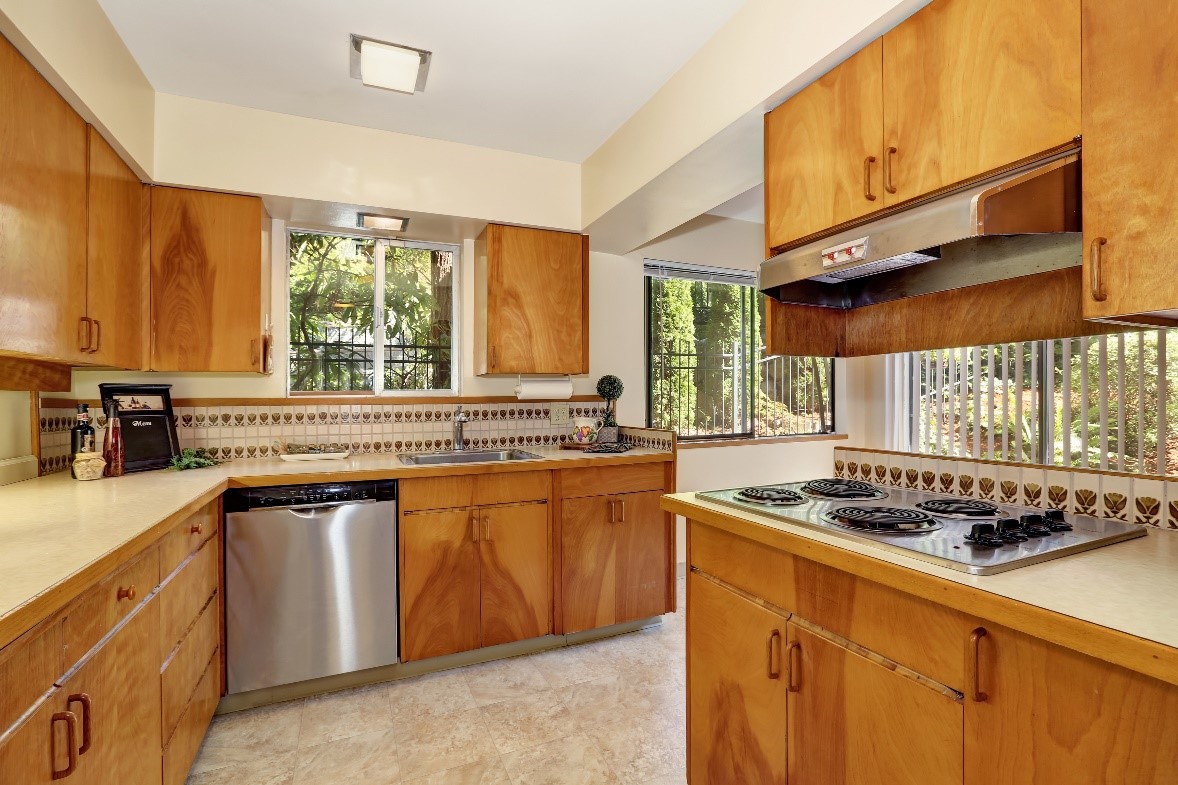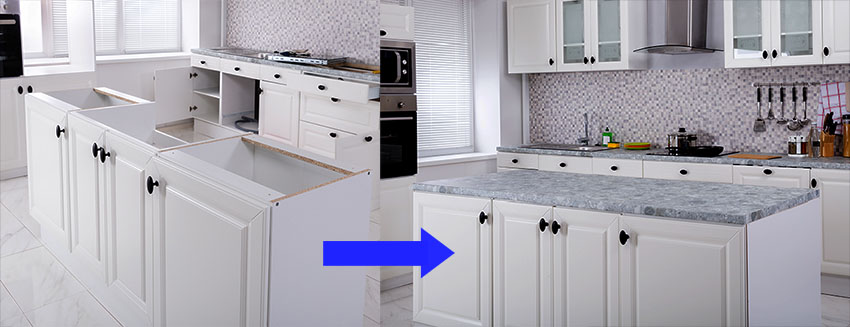Cabinet Replacement Options

Replacing your kitchen cabinets without replacing your quartz countertops is a common and cost-effective way to refresh your kitchen’s look. Several options exist, each offering unique advantages and disadvantages. This section will discuss the different cabinet replacement options and their pros and cons.
Full Cabinet Replacement
Full cabinet replacement involves removing all existing cabinets and installing entirely new ones. This option provides the most significant transformation, allowing you to choose any style, material, and configuration.
Pros
- Complete Customization: Full replacement allows you to select cabinets that perfectly match your desired style, size, and features.
- Improved Functionality: You can choose cabinets with better storage solutions, such as pull-out drawers, spice racks, or lazy Susans, to enhance your kitchen’s functionality.
- Enhanced Durability: New cabinets are typically made from higher-quality materials, ensuring long-lasting performance and durability.
Cons
- High Cost: Full cabinet replacement is the most expensive option, requiring significant labor and materials.
- Extensive Disruption: The entire kitchen will be disrupted during the installation process, requiring temporary relocation of appliances and belongings.
- Longer Timeframe: The installation process takes longer compared to other options, potentially requiring several days or weeks.
Cabinet Refacing
Cabinet refacing involves covering the existing cabinet boxes with new materials, such as veneer, laminate, or paint, while replacing the doors and drawer fronts. This option provides a significant visual upgrade without the need for full replacement.
Pros
Cons
Cabinet Door Replacement
Replacing only the cabinet doors and drawer fronts is the least invasive option, offering a simple and affordable way to update your kitchen’s look.
Pros
Cons
Quartz Countertops

Quartz countertops are a popular choice for kitchens and bathrooms due to their durability, low maintenance, and aesthetic appeal. If you’re planning to replace your cabinets, you may be wondering if you can keep your existing quartz countertops. In most cases, the answer is yes. However, there are some considerations to keep in mind.
Benefits of Keeping Quartz Countertops
Keeping your existing quartz countertops during a cabinet replacement can save you money and time. Quartz countertops are known for their durability and resistance to scratches, stains, and heat. This makes them a long-lasting and practical choice for kitchens and bathrooms. Additionally, quartz countertops are relatively low maintenance, requiring only regular cleaning with mild soap and water. They also come in a wide range of colors and patterns, allowing you to find a style that complements your existing decor.
Challenges of Working Around Quartz Countertops
While keeping your existing quartz countertops can be advantageous, it does present some challenges during cabinet replacement.
Measuring and Fitting
Precise measurements are crucial when working around existing countertops. You’ll need to ensure that the new cabinets fit seamlessly with the countertop overhang and that there is sufficient space for appliances and other fixtures. Incorrect measurements can lead to gaps, misalignment, and potential damage to the countertop.
Backsplash Integration
If your existing backsplash is integrated with the countertop, you’ll need to consider how to handle it during the cabinet replacement. Replacing the backsplash may be necessary if it doesn’t align with the new cabinet heights or if it’s damaged.
Potential for Damage
Quartz countertops are durable, but they are not indestructible. During the cabinet replacement process, there is a risk of damage to the countertop, especially if the work is not done carefully. It’s essential to hire a reputable contractor with experience working around existing countertops to minimize the risk of damage.
Seamless Integration of New Cabinets
To ensure a seamless integration of new cabinets with existing quartz countertops, consider the following:
Countertop Overhang
The overhang of the countertop beyond the cabinet edge should be consistent throughout the kitchen or bathroom. If the new cabinets are shallower than the existing ones, you may need to adjust the countertop overhang to create a uniform look.
Cabinet Depth
The depth of the new cabinets should match or be slightly shallower than the existing countertop overhang. If the new cabinets are deeper, you may need to adjust the countertop overhang or consider replacing the countertop entirely.
Design Harmony
Consider the overall design harmony of the kitchen or bathroom when choosing new cabinets. The style and color of the new cabinets should complement the existing quartz countertops and create a cohesive look.
Practical Considerations: Can You Replace Cabinets Without Replacing Quartz Countertops

Replacing cabinets while retaining your existing quartz countertops is a project that requires careful planning and execution. This process involves several steps, from initial planning to final finishing touches, and requires a keen understanding of the involved procedures.
Planning and Preparation
Thorough planning is crucial for a successful cabinet replacement project. It involves defining your needs, choosing the right cabinets, and coordinating with professionals. Here are some essential steps:
- Define Your Needs: Determine the desired style, functionality, and budget for your new cabinets. Consider the size and layout of your kitchen and how the new cabinets will integrate with your existing quartz countertops.
- Choose Cabinets: Research and select cabinets that meet your needs and preferences. Consider the material, finish, and style. Explore options like pre-made cabinets, semi-custom cabinets, or fully custom cabinets.
- Measure and Plan: Carefully measure your existing cabinets and the space available. Create a detailed plan that includes the dimensions and placement of the new cabinets.
- Coordinate with Professionals: If you are not a skilled DIYer, consider hiring professionals for cabinet installation. This ensures proper installation and minimizes the risk of damage to your existing countertops.
Demolition and Removal
The demolition phase involves removing the existing cabinets and preparing the space for the new ones. This step requires careful execution to avoid damaging the quartz countertops.
- Remove Doors and Drawers: Begin by removing all cabinet doors and drawers to lighten the weight and facilitate removal.
- Disassemble Cabinets: Carefully disassemble the existing cabinets, taking note of the assembly process for reassembly later. Use a pry bar or other appropriate tools to separate the cabinets from the walls and countertop.
- Remove Cabinet Boxes: Once the cabinets are disassembled, carefully remove the cabinet boxes. Be mindful of the quartz countertops and avoid scratching or damaging them during this process.
- Clean Up: After removing the cabinets, clean the area thoroughly to remove debris and dust.
Installation
Installing new cabinets requires precision and care, ensuring a seamless fit with the existing countertops.
- Prepare the Space: Level the walls and floor to ensure the new cabinets are installed correctly. Use shims to adjust for any unevenness.
- Install Base Cabinets: Start by installing the base cabinets. Secure them to the walls and floor using appropriate screws and fasteners.
- Install Upper Cabinets: Install the upper cabinets after the base cabinets are securely in place. Ensure proper alignment and spacing.
- Install Hardware: Once the cabinets are installed, attach the doors, drawers, and hardware.
Finishing Touches, Can you replace cabinets without replacing quartz countertops
After installation, there are a few finishing touches to complete the project.
- Caulking and Sealing: Apply caulk around the edges of the cabinets and countertops to create a smooth and water-resistant seal.
- Cleaning and Polishing: Clean the cabinets thoroughly to remove dust and debris. Polishing the countertops restores their shine and protects them from scratches.
Tools and Materials
Having the right tools and materials on hand is essential for a successful cabinet replacement project.
- Tools:
- Measuring Tape: For accurate measurements of the space and cabinets.
- Level: To ensure cabinets are installed level and straight.
- Screwdriver: For attaching screws and fasteners.
- Pry Bar: For separating cabinets from the walls and countertop.
- Drill: For drilling holes for screws and fasteners.
- Hammer: For driving nails and securing cabinets.
- Saw: For cutting wood and adjusting cabinet sizes.
- Caulk Gun: For applying caulk around the edges of the cabinets and countertops.
- Safety Glasses and Gloves: For protecting your eyes and hands during demolition and installation.
- Materials:
- Cabinets: Choose cabinets that meet your needs and preferences.
- Screws and Fasteners: For securing the cabinets to the walls and floor.
- Caulk: For sealing the edges of the cabinets and countertops.
- Shims: For adjusting for unevenness in the walls and floor.
- Cleaning Supplies: For cleaning the cabinets and countertops after installation.
Can you replace cabinets without replacing quartz countertops – While replacing cabinets without replacing quartz countertops is certainly possible, it’s important to consider the overall aesthetic. If you’re looking for a fresh look, perhaps consider incorporating black and white bedroom wall decor into your kitchen design. This timeless color scheme can create a striking contrast against your quartz countertops, allowing your new cabinets to truly shine.
Replacing cabinets without replacing quartz countertops is a common kitchen renovation strategy. Quartz countertops are durable and often retain their appeal even after years of use, making them a strong candidate for keeping. If you’re aiming for a fresh look, consider a classic pairing like blue countertops with white cabinets.
This combination creates a timeless and elegant aesthetic, making it a great choice for both modern and traditional kitchens. By updating the cabinets, you can revitalize your kitchen’s design without the added expense of replacing the countertops.